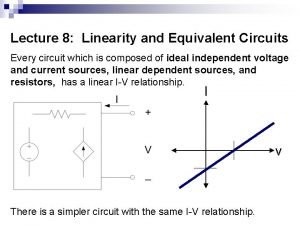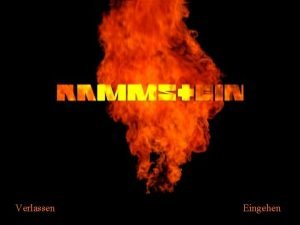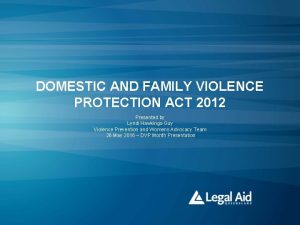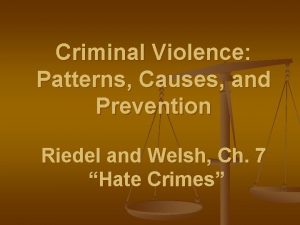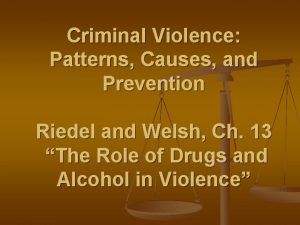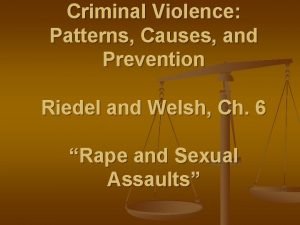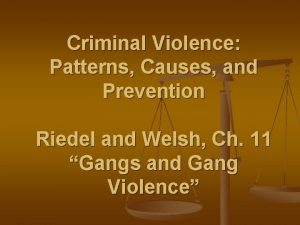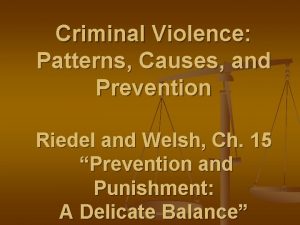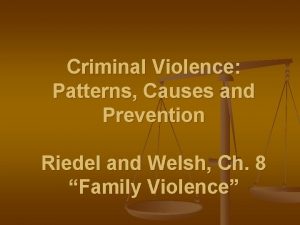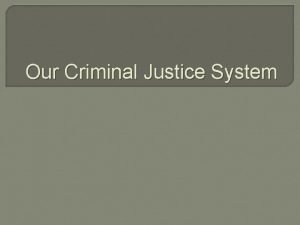Criminal Violence Patterns Causes and Prevention Riedel and






















- Slides: 22

Criminal Violence: Patterns, Causes, and Prevention Riedel and Welsh, Ch. 14 “Terrorism”

OUTLINE n Patterns and Trends n n n Explanations n n Strain Theory Social Learning Theory Conflict Theory Interventions n n n A Brief History of Terrorism State-Sponsored Terrorism Terrorist Tactics Types of Terrorists Terrorist Incidents The 9/11 Report: A Global Strategy The Patriot Act Military Action Diplomacy and International Cooperation Conclusion

Definitions Terrorism: “the unlawful use of force and violence against persons or property to intimidate or coerce a government, the civilian population, or any segment thereof, in furtherance of political or social objectives” (FBI, 2002, iii) Terrorist incident: “a violent act or an act dangerous to human life in violation of the criminal laws of the United States, or of any state, to intimidate or coerce a government, the civilian population, or any segment thereof, in furtherance of political or social objectives” (FBI, 2002, iv)

Definitions (cont. ) Domestic Terrorism: activities that involve acts dangerous to human life that are a violation of the criminal laws of the United States or of any state; appear to be intended to intimidate or coerce a civilian population; to influence the policy of a government by mass destruction, assassination, or kidnapping; and occur primarily within the territorial jurisdiction of the United States (FBI, 2002) International Terrorism: the unlawful use of force or violence committed by a group or an individual, who has some connection to a foreign power or whose activities transcend national boundaries, against persons or property to intimidate or coerce a government, the civilian population or any segment thereof, in furtherance of political or social objectives (FBI, 2002)

A Brief History of Terrorism n n French Revolution (1789– 1799) -- where a “reign of terror” referred to revolutionary, anti-monarchy, and anti-government activity before and after the war Mid-1800 s -- the term was used to describe violent revolutionaries who revolted against governments End of 1800 s to early 1900 s -- terrorism was used to describe the violent activities of many diverse groups, including organized labor unions, anarchists, nationalist groups revolting against foreign powers, and ultranationalist political organizations 1930 s -- the term came to refer to practices of repression used by totalitarian states (Italy, Germany, Russia) against their own citizens

n n Late 1940 s and 1950 s --“terrorism” was used to describe numerous nationalist, anti-colonialist groups that emerged following the post-World War II reorganization of Europe Late 1960 s and early 1970 s -- the Palestinian Liberation Organization (PLO) fueled the “internationalization” of terrorism first with a hijacking of an Israeli El Al flight in 1968, then the Munich Olympic murders of 11 Israeli athletes in 1972 by Black September, a militant splinter group Early 1980 s -- at least 40 different terrorist groups had been trained by PLO at various camps in the Middle East Mid-1990 s to present -- the term “terrorism” has begun to refer to broader, less distinct phenomena, including covert warfare whereby weaker states or groups confront larger, more powerful rivals

State-Sponsored Terrorism n n The emergence of state-sponsored terrorism is one of the most important developments of recent years. Some governments have embraced terrorism as a deliberate instrument of foreign policy, a cost-effective means of waging war covertly through the use of terrorists as surrogate warriors or mercenaries.

Terrorist Tactics n n n Traditionally, terrorists have employed six major tactics: bombing, hijacking, arson, assault, kidnapping, and taking hostages. In recent years emerging tactics have included threats of chemical and biological weapons, as well as weapons of mass destruction, including nuclear weapons. The disruption of services through electronic hacking (cyberterrorism) could perhaps be added as another emerging threat.

Types of Terrorists: al Qaeda n n The professional cadre is the most dedicated, committed, and professional soldiers of al Qaeda, entrusted with the most important and high-value attacks. At the next level down, trained amateurs receive some training and funding, but they are distinctly less professional, less dedicated, less well supported, and more expendable than the professional cadre. Local walk-ins refer to Islamic radicals who come up with an idea for a terrorist attack on their own and then pursue funding from al Qaeda. Like-minded insurgents, guerrillas, and terrorists include existing groups who may have benefited from bin Laden’s support in myriad ways, including training, material (arms) or tactical support. Bin Laden provides such aid to radical Islamic groups to further his cause of global jihad.

n n Types of Terrorists: Other National separatists primarily seek changes in territories or boundaries related to desired independence and/or new political identities. They tend to see “their” land as occupied by foreigners who must be driven out. Revolutionary leftists primarily wish to alter fundamental political and social relationships and governance within an existing state. These groups wish to overthrow the existing government and replace it with a structure sympathetic to the oppressed masses. Reactionary rightist groups generally seek to defend existing power relationships and inequalities or return to a previous status quo. This category includes neo-Nazi groups in Germany. Religious terrorism: Terrorism motivated either in whole or in part by a religious imperative, where violence is regarded by its practitioners as a divine duty or sacramental act, embraces markedly different means of justification that committed by secular terrorists.

Terrorist Incidents n n To establish the repository for the U. S. Government's database on terrorist incidents, in 2005 NCTC unveiled the Worldwide Incidents Tracking System (WITS), which allows public access to the NCTC data. According to the counting rules used by NCTC, approximately 11, 800 terrorist attacks against noncombatants occurred in various countries during 2008, resulting in over 54, 000 deaths, injuries, and kidnappings. The largest number of reported terrorist attacks occurred in the Near East (nearly 40%), but South Asia had the greater number of fatalities. These two regions were also the locations for 75% of the 235 high-casualty attacks (those that killed 10 or more people) in 2008. The perpetrators of over 60% of attacks in 2008 could not be determined from open source (publicly available) information.

Worldwide Terrorist Attacks, 2008: Number of Fatalities and Incidents by Region Source: National Counterterrorism Center (2009). 2008 Report on Terrorism. Washington, DC: USGPO)

Explanations Strain Theory: Adaptations to strain (discrepancy between cultural goals and institutionalized means) include: Rebellion (e. g. , Cohen’s “Reaction Formation”). This adaptation explains some types of terrorism.

Religious Beliefs Hoffman(1998): religious beliefs can provide the motivations and justification for violence. n n For the religious terrorist, violence is first and foremost a sacramental act or divine duty executed in response to some theological demand or imperative. Religious terrorists often seek to eliminate broadly defined categories of enemies and accordingly regard such large-scale violence not only as morally justified but as a necessary expedient to attain their goals.

An Emergent Model of Terrorism? Cultural Goals Social Structure Anomie, Strain Poverty, Inequality Political Beliefs Innovation? Religious beliefs Rebellion? Individual Emotional Responses & Coping Conformity? Lifestyles Retreatism? Terrorism?

Social Learning Theory n n Social learning theory proposes that criminal behavior, including but not limited to terrorist acts, is acquired, reinforced, and maintained through interactions with significant others, especially one’s primary group (family, peers, friends and neighbors) but also through secondary agents of socialization (e. g. , social, religious, and political organizations). Through such interactions, one may learn definitions favorable or unfavorable to deviant acts, including terrorism. n n These include attitudes and beliefs, rationalizations, justifications, and definitions of situations (such as suicide bombings) as right or wrong, moral or immoral, justified or unjustified, and ethical or unethical. Religious terrorists in particular are heavily schooled in definitions conducive to anti-U. S. hatred and terrorism through numerous Islamic schools and madrassahs.

Conflict Theory Turk (1990): Conflicts between dominant & subordinate groups may be resolved not only by consensual methods, but also by deception & force. n Terrorism is associated with the breakdown of traditional authority structures and with efforts to create new ones. n Awareness and resentment of political coercion and social inequality do not usually lead to terrorism, but lower-class socialization is more likely to reflect experiences of material and cultural deprivation and defeat, while higher-class socialization reflects experiences of privilege & success. n Within lower classes, the imagery of terrorism may attract the young and the politically inexperienced, who have not internalized the accommodations of dominance and deference.

Interventions: The 9/11 Report: A Global Strategy The Commission proposed a threepronged strategy: 1. Attack terrorists and their organizations 2. Prevent the continued growth of Islamist terrorism 3. Protect against and prepare for terrorist attacks n

The Patriot Act n n The Act consists of more than 150 sections. Changes were made to national security authorities, the substantive criminal law, immigration law, money-laundering statutes, victim assistance statutes, and other areas. At least seven provisions have been criticized: n n n n The indefinite detention of citizens along with the suspension of habeas corpus (the legal right to challenge one’s detention); The increased monitoring of electronic communications, financial transactions, educational and immigration status, and library records The secret taping of attorney/client exchanges The creation of military tribunals with the authority to try and sentence (including to capital punishment) both foreign nationals and American citizens defined as enemy combatants The relaxing of the prohibition of assassination to permit the extralegal killing of suspected terrorists, whether foreigners or citizens The elimination of the barrier to information exchanges between national intelligence agencies and local law enforcement agencies The unlimited access to all data files on targeted individuals and groups, as well as the proposed creation of a technologically sophisticated (e. g. , DNA code) identification card that would facilitate surveillance

Military Action n n Although Article 51 of the United Nations Charter grants nations the right of self-defense, scholars continue to debate whether the U. S. was legally justified under international law to undertake military action in Afghanistan and Iraq. The Bush administration offered three main reasons for the decision to invade Iraq: 1. 2. 3. n Saddam Hussein was thought to be manufacturing and hiding weapons of mass destruction. World support for the war against Iraq was widespread. The Iraqi regime was thought to be closely tied to al Qaeda and other terrorist groups. While many agree that an effective counterterrorism strategy must include a broad range of national and international initiatives, both military and diplomatic, there is much disagreement over the appropriate mix of diplomacy v. force.

Diplomacy and International Cooperation n n The U. S. counterterrorism strategy must also focus on rebuilding the international consensus against terrorism that flourished briefly during the 1980 s, but then fell into neglect. Through regional partnerships, the U. S. is attempting to build networks that undermine, marginalize, and isolate terrorists, discredit terrorist ideology, and empower legitimate alternatives to extremism.

Conclusions n n n A comprehensive counterterrorism strategy must be multifaceted and balanced in its approach, and such a strategy will require considerable national and international cooperation and resources. There is little doubt that force alone will be insufficient to combat terrorism at home or abroad. An effective counterterrorism strategy must: n Understand the inner logic that motivates terrorists n Develop countermeasures to reduce fear n Develop realistic expectations and responses n Address hostility toward the U. S. through a comprehensive program of international, multilateral diplomacy
 Primary prevention secondary prevention tertiary prevention
Primary prevention secondary prevention tertiary prevention Criminal thinking worksheets
Criminal thinking worksheets Criminal and addictive thinking
Criminal and addictive thinking Electric circuits nilsson
Electric circuits nilsson Reidels
Reidels Ryszard riedel biografia
Ryszard riedel biografia Małgorzata pol
Małgorzata pol Ssi vorteile rechner
Ssi vorteile rechner Riedel frota
Riedel frota Klaus riedel
Klaus riedel Thevenin and norton
Thevenin and norton Mexikaner ramstein
Mexikaner ramstein Theran riedel
Theran riedel Proximate cause and ultimate cause
Proximate cause and ultimate cause Proximate and ultimate causes of behaviour
Proximate and ultimate causes of behaviour X videos
X videos The curving of these planetary winds is the result of
The curving of these planetary winds is the result of Dating serves several important functions that include:
Dating serves several important functions that include: Ignorance modifiers of human acts
Ignorance modifiers of human acts Domestic and family violence protection act 2012
Domestic and family violence protection act 2012 Gandhi king and mandela what made non-violence work dbq
Gandhi king and mandela what made non-violence work dbq Chapter 9 lesson 2 resolving conflicts
Chapter 9 lesson 2 resolving conflicts Chapter 27 anger aggression and violence
Chapter 27 anger aggression and violence










